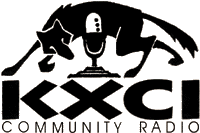
KGUN-TV is a television station in Tucson, Arizona, United States, affiliated with ABC. It is owned by the E. W. Scripps Company alongside Sierra Vista-licensed CW affiliate KWBA-TV. Both stations share studios on East Rosewood Street in east Tucson, while KGUN-TV's transmitter is located atop Mount Bigelow, northeast of the city.

KHRR is a television station in Tucson, Arizona, United States, serving as the market's outlet for the Spanish-language network Telemundo. Owned and operated by NBCUniversal's Telemundo Station Group, the station maintains studios on North Stone Avenue in downtown Tucson, and its transmitter is located atop the Tucson Mountains.

KGME is a commercial radio station in Phoenix, Arizona, featuring a sports format known as "Fox Sports 910." Owned by iHeartMedia, the station's studios are located in Phoenix near Sky Harbor International Airport, and broadcasts with 5,000 watts—directional at night—from a transmitter site at the intersection of 30th and Maryland Avenues in north Phoenix. In addition to a standard analog transmission, KGME is relayed over the second HD Radio subchannel of KESZ and is available online via iHeartRadio.

KXCI is a non-commercial, listener-supported, FM radio station in Tucson, Arizona. It is owned by the non-profit Foundation for Creative Broadcasting. Its call sign comes from the Roman numeral for 91 (XCI). The studios and offices are on South 4th Avenue. Its transmitter is on East Mount Bigelow Road in Whitetail, Arizona.

KHUD is a country radio station in Tucson, Arizona. It is owned by iHeartMedia, Inc.. The radio studios and offices are located north of downtown Tucson along Oracle Road. On weekdays, KHUD carries two nationally syndicated country music shows from co-owned Premiere Networks: The Bobby Bones Show in morning drive time and After Midnite with Granger Smith, heard overnight.

KMMA is a commercial FM radio station licensed to Green Valley, Arizona and serving the Tucson metropolitan area. It carries a Spanish Contemporary radio format and is owned by iHeartMedia, Inc. The studios are on North Oracle Road.

KUAT-FM is a radio station in Tucson, Arizona, United States. One of two radio services operated by the University of Arizona (UA) through its Arizona Public Media arm, it broadcasts a classical format throughout Southern Arizona. Studios are in the Modern Languages Building on the UA campus.

KLPX is a commercial radio station in Tucson, Arizona. It is owned by Lotus Communications and airs a classic rock radio format. Local DJs are heard during the day and the syndicated "Nights with Alice Cooper" show is heard evenings. The station uses the slogan "#1 for Classic Rock". KLPX's studios and offices are on North Commerce Drive. Its transmitter is located on Tower Peak in the Tucson Mountains near Saguaro National Park.
KTAR is an AM commercial radio station licensed to Phoenix, Arizona, United States. Owned and operated by Bonneville International, it features a sports format airing programming from ESPN Radio. The studios are located in north Phoenix near Piestewa Peak, and the station broadcasts with 5,000 watts from a transmitter site near the corner of 36th Street and Thomas Road.
KOAN is a commercial radio station in Anchorage, Alaska. It is owned by Iglesia Pentecostal Vispera del Fin. Its studios are located on Business Park Boulevard in Anchorage, and its transmitter is located in South Anchorage.

KNST is a commercial radio station in Tucson, Arizona, airing a news/talk radio format. The station is owned by iHeartMedia and serves Greater Tucson, including the suburbs of Marana, Oro Valley, Green Valley, Sahuarita, Sierra Vista, and Vail. KNST's studios and offices are on Oracle Road, north of Downtown Tucson.
KVOI is a commercial radio station licensed to Cortaro, Arizona, and serving the Tucson metropolitan area. It is owned by Bustos Media and it airs a talk radio format. The studios are on South Richey Avenue in Tucson.

KTKT – branded La Buena 94.3 – is a commercial Spanish language adult hits radio station licensed to serve Tucson, Arizona. Owned by Lotus Communications, the covers the Tucson metropolitan area and Southern Arizona. The KTKT studios and transmitter are both located in northwest Tucson; in addition to a standard analog transmission, KTKT is simulcast over low-power Tortolita translator K232FD, and is available online.

KGMS is a radio station broadcasting a Christian talk and teaching format. It is licensed to Tucson, Arizona. The station is owned by Robert and Luann Wilkins, through licensee Tucson Christian Radio, Inc. National religious leaders heard on KGMS include David Jeremiah, John MacArthur, Chuck Swindoll, Charles Stanley and Alistair Begg. It is part of the Wilkins Radio Network.
KEVT was a radio station licensed to Sahuarita, Arizona, United States, and served the Tucson area. KEVT was owned by One Mart Corporation.
WNMA is a radio station licensed to Miami Springs, Florida, serving the Miami metropolitan area. It airs a Spanish and English-language classic hits format. The station is owned by Multicultural Broadcasting and currently operated by Adrian Pontes.
KIKX was a radio station on 580 kHz in Tucson, Arizona, which operated from April 10, 1947, until closing on July 18, 1982. The station lost its FCC license due to a 1974 kidnapping hoax involving one of the station's disc jockeys.
KFBR was a radio station on 1340 AM serving Nogales, Arizona. It operated from 1967 to 1993 and was the successor to KNOG, which broadcast on the same frequency from 1948 to 1965. KNOG was the first radio station in Nogales, Arizona, and for its entire existence until 1978, KNOG/KFBR was the only English-language radio station in the city.

Arizona Public Media (AZPM) is the public broadcasting service of the University of Arizona, providing radio and television service and regional news coverage in southern and southeastern Arizona from its studios in Tucson. AZPM encompasses two primary radio services aligned with NPR, with KUAZ and KUAZ-FM in Tucson airing news and talk programming and KUAT-FM airing classical music, and KUAT-TV "PBS 6", the PBS station for the region. AZPM is housed in the Modern Languages Building on the UA campus.
KWJB was the call sign for several radio stations in Globe, Arizona. Two separate licenses on the 1240 kHz frequency, and an FM station on 100.3 MHz, used the call letters. The first KWJB signed on in 1938, being joined by the FM station in 1958. After going silent October 29, 1960, the licenses of both stations were ordered revoked by the Federal Communications Commission (FCC) in 1961 along with all other stations owned by Gila Broadcasting. A second AM station in Globe on the same frequency, but a different license, operated as KWJB between 1969 and 1975.












